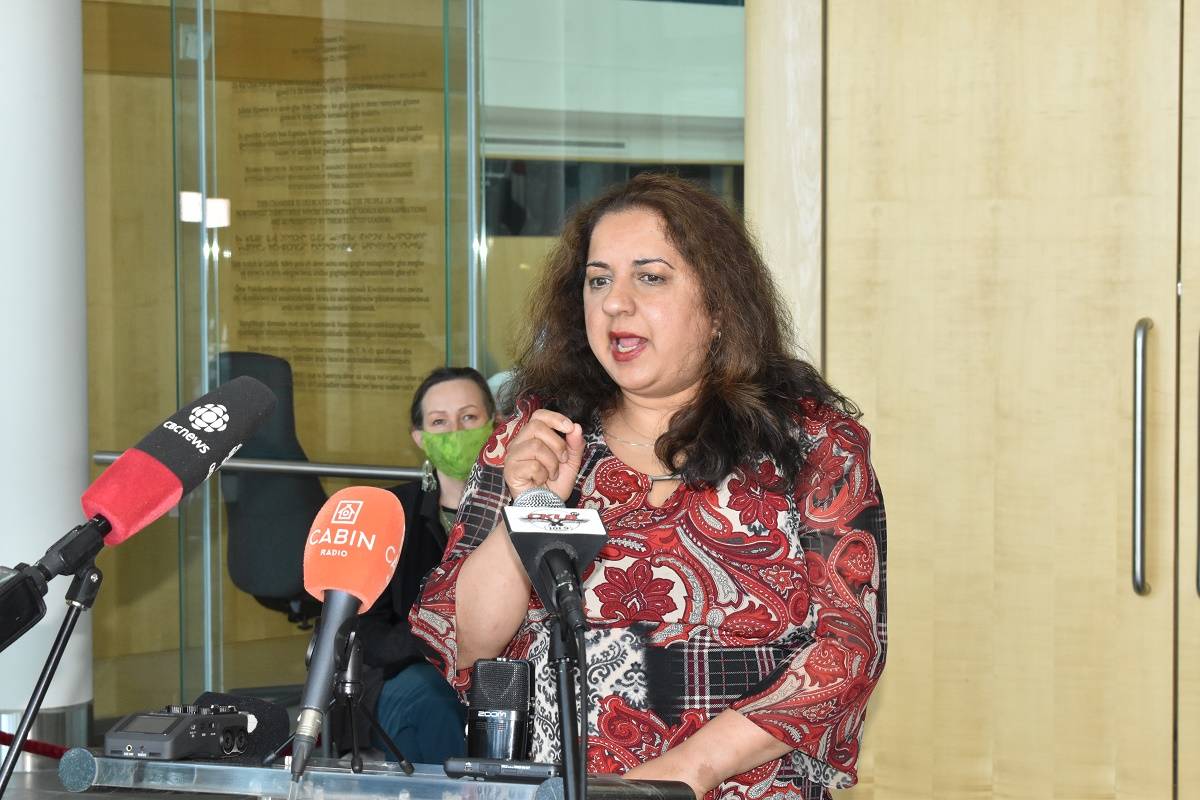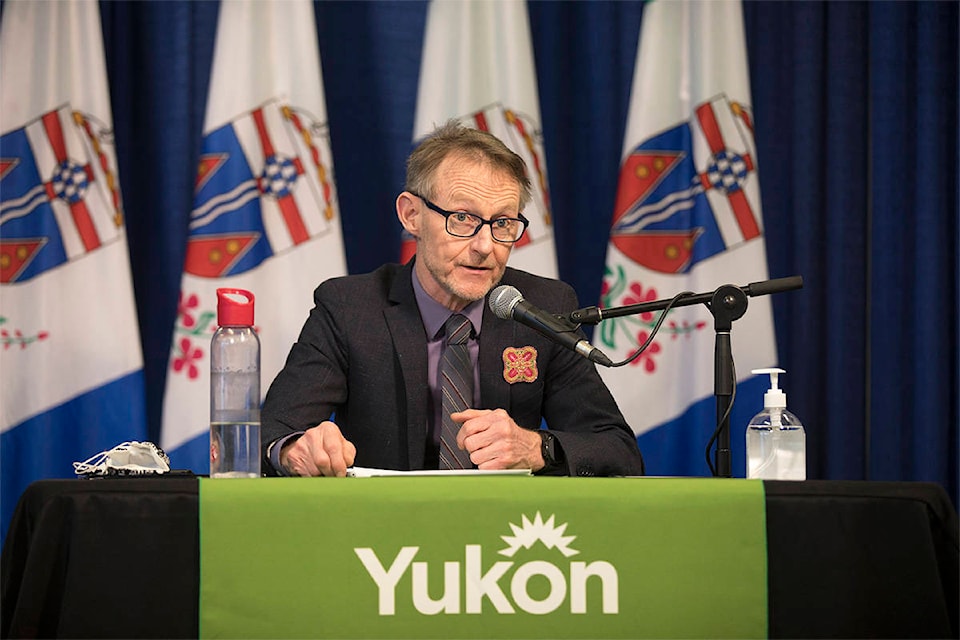As the Yukon prepares to relax travel restrictions, Yellowknifers are still wearing masks in offices.
On May 5, the Yukon government announced that on May 25 it will end mandatory self-isolation for fully vaccinated people entering the territory from anywhere in Canada. Travellers must be able to confirm their vaccination status.
READ HERE: Yukon lifting restrictions as vaccine uptake increases
Bars and restaurants would also be able to return to full capacity.
Despite both being Northern territories with similar populations, the NWT isn’t yet at the point where it can replicate its western neighbour’s relaxation of COVID-19 restrictions.
More control over COVID-19 in Yukon
The Yukon’s Office of the Chief Medical Officer of Health (OCMOH) assessed earlier in May that with its high and rising rate of vaccination of residents, it was able to reevaluate health measures and recommend changes that would keep the territory safe but also allow moves towards normalcy, said OCMOH spokesperson Patricia Living.
“Our case counts are low, no community spread for the past 14 months, and high vaccination rates and pretty good adherence to the safe six plus one (steps),” said Living, referring to the Yukon’s set of COVID-19 safety tips on social distancing, hand washing and other guidelines similar to those of the NWT.
As of May 13, 74 per cent of Yukoners had received their first vaccine dose and 66 per cent had received their second.
In the NWT, 66 per cent of residents received their first dose and 58 per cent were fully vaccinated, according to the GNWT’s COVID-19 Dashboard.
“For individuals who are vaccinated and two weeks past their second dose, the risk of them acquiring COVID-19 is very, very low and if they did contract, chances of passing on to others is also likely to be low. The risk, based on vaccination rates, can no longer be justified for fully-vaccinated individuals,” Living added.
Yukon’s COVID-19 case count sat at 84 as of May 13. The territory has also experienced two deaths as a result of the virus. The NWT had trailed behind Yukon in its coronavirus cases until the recent N.J. Macpherson School outbreak pushed infection numbers up to 144.
That outbreak increased the territory’s case count by 63 infections in just 12 days, after the first case was announced on May 1.
RELATED REPORTING: Two more confirmed cases in Yellowknife
RELATED REPORTING: N.J. Macpherson School in YK closed after COVID-19 case confirmed
‘Risk from Alberta too high’
From the perspective of NWT chief public health officer (CPHO) Dr. Kami Kandola, the situation facing the NWT isn’t comparable to that of the Yukon.
At a news conference on May 7, Kandola told reporters that the main obstacle to changing border protection measures is the territory’s high importation risk from Alberta, where active COVID-19 infections are at the highest rate in Canada. The province had 24,962 active cases as of May 11.
“They’re also where most of our travellers come from,” Kandola said.
By contrast, Yukon faces a milder threat from its neighbouring jurisdictions.
In B.C, there were 5,887 active cases of COVID-19 on May 12. To its west, Alaska had 84 active cases, according to data from the Alaska Department of Health and Social Services.
READ HERE: COVID-19 DAILY SUMMARY
Kandola also cited the possibility that vaccinated individuals could still catch COVID-19 as vaccines aren’t 100 per cent effective against infection.
“The most prudent measure that we’ve taken is to have fully-vaccinated individuals isolate for seven days. (If they) test negative on day eight then they can safely self-monitor the second week,” she said. “We’re dealing with a large scale outbreak in Yellowknife so we really can’t afford to have more infected travellers transmitted at this point.”
‘When will restrictions ease?’
For Yellowknife North MLA Rylund Johnson, it’s understandable that the Yukon’s lower geographic and travel risk and its higher vaccine uptake puts it in a better position to relax border rules.
At the same time, he would like to see more clarity from local health authorities on what needs to happen in the NWT before Yukon’s approach can be followed.
“We need a clear date for when the border restrictions will ease up. But once we get to 75 per cent vaccination or higher, based on the risk, it seems there is no path forward but eased restrictions for fully-vaccinated people. At the very least we should get a Yukon travel bubble,” he said.
Cautious approach of tourism industry
NWT businesses in the tourism industry are among those that would stand to benefit the most from the removal of isolation requirements.
But for some companies, a quick rule change wouldn’t necessarily invite an influx of clients.
Peterson’s Point Lake Lodge, whose traditional guests have come from the U.S. or other parts Canada, could finally receive more bookings, after the difficult July-September 2020 season when it had none.
RELATED REPORTING: Covid hands Peterson’s Point Lake Lodge a chance to cater more to Northern tourists
“I don’t know if it would be business as usual because some people would still be reluctant to travel,” said owner Amanda Peterson. “I know there will be a lot of conservative people who aren’t ready to travel. Some of our demographic is an older demographic and could be more vulnerable. Other members of our demographic would want to travel. More Americans would come if the Canadian border was open.”
Dan Wong, owner of Jackpine Paddle, said he supports CPHO policies and is in no rush to remove border restrictions, even though most of his clientele tends to come from outside the territory.
About 40 per cent of his customers are American, close to 20 per cent are European and the other 40 per cent are from Canadian jurisdictions. Northerners have made up only about five per cent.
RELATED REPORTING: New focus guides Jackpine Paddle to calm waters
“Variants are more infectious and case numbers in Canada are still very high, but we should always be re-evaluating as conditions change and our NWT vaccination rate grows,” he said.
For Frontier Lodge in Lutsel K’e, a border reopening in the near future would have little impact on the lodge’s business.
“This rule change won’t do much for tourism with only three per cent of our country having been fully vaccinated,” said general manager Corey Myers.
The lodge has been busy in the last few weeks planning how it will accommodate guests for the summer after it successfully cleared a bureaucratic logjam inApril and received its liquor licence. That will permit it to receive guests and enjoy some measure of a tourism season.
RELATED REPORTING: Frontier Lodge overcomes bureaucratic headaches, readies for summer guests
But a change like Yukon’s would have to have been announced earlier to benefit Frontier this summer.
“If we wanted any hope of a bringing back a significant number of our non-NWT clients, both Canadian and international, we needed a clear plan for what this summer would look like six months ago,” Myers said.

